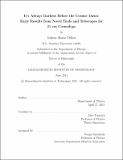| dc.contributor.advisor | Max Tegmark. | en_US |
| dc.contributor.author | Dillon, Joshua Shane | en_US |
| dc.contributor.other | Massachusetts Institute of Technology. Department of Physics. | en_US |
| dc.date.accessioned | 2015-10-14T14:35:51Z | |
| dc.date.available | 2015-10-14T14:35:51Z | |
| dc.date.copyright | 2015 | en_US |
| dc.date.issued | 2015 | en_US |
| dc.identifier.uri | http://hdl.handle.net/1721.1/99255 | |
| dc.description | Thesis: Ph. D., Massachusetts Institute of Technology, Department of Physics, 2015. | en_US |
| dc.description | This electronic version was submitted by the student author. The certified thesis is available in the Institute Archives and Special Collections. | en_US |
| dc.description | Cataloged from student-submitted PDF version of thesis. | en_US |
| dc.description | Includes bibliographical references (pages 463-490). | en_US |
| dc.description.abstract | 21 cm cosmology, the statistical observation of the high redshift universe using the hyperfine transition of neutral hydrogen, has the potential to revolutionize our understanding of cosmology and the astrophysical processes that underlie the formation of the first stars, galaxies, and black holes during the "Cosmic Dawn." By making tomographic maps with low frequency radio interferometers, we can study the evolution of the 21 cm signal with time and spatial scale and use it to understand the density, temperature, and ionization evolution of the intergalactic medium over this dramatic period in the history of the universe. For my Ph.D. thesis, I explore a number of advancements toward detecting and characterizing the 21 cm signal from the Cosmic Dawn, especially during its final stage, the epoch of reionization. In seven different previously published or currently submitted papers, I explore new techniques for the statistical analysis of interferometric measurements, apply them to data from current generation telescopes like the Murchison Widefield Array, and look forward to what we might measure with the next generation of 21 cm observatories. I focus in particular on estimating the power spectrum of 21 cm brightness temperature fluctuations in the presence enormous astrophysical foregrounds and how those measurements may constrain the physics of the Cosmic Dawn. | en_US |
| dc.description.statementofresponsibility | by Joshua Shane Dillon. | en_US |
| dc.format.extent | 490 pages | en_US |
| dc.language.iso | eng | en_US |
| dc.publisher | Massachusetts Institute of Technology | en_US |
| dc.rights | M.I.T. theses are protected by copyright. They may be viewed from this source for any purpose, but reproduction or distribution in any format is prohibited without written permission. See provided URL for inquiries about permission. | en_US |
| dc.rights.uri | http://dspace.mit.edu/handle/1721.1/7582 | en_US |
| dc.subject | Physics. | en_US |
| dc.title | It's always darkest before the cosmic dawn : early results from novel tools and telescopes for 21 cm cosmology | en_US |
| dc.title.alternative | Early results from novel tools and telescopes for 21 cm cosmology | en_US |
| dc.type | Thesis | en_US |
| dc.description.degree | Ph. D. | en_US |
| dc.contributor.department | Massachusetts Institute of Technology. Department of Physics | |
| dc.identifier.oclc | 922938524 | en_US |
